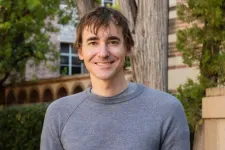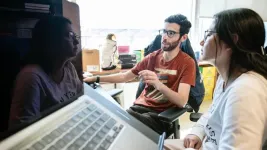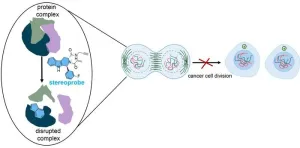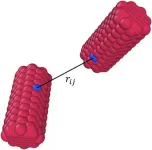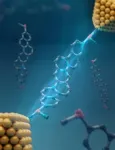(Press-News.org) Researchers from the California NanoSystems Institute at UCLA and their colleagues have received a one-year, $1 million grant as part of a new National Science Foundation program aimed at accelerating the development and commercialization of quantum technologies for the benefit of society.
The Quantum Sensing and Imaging Lab, or Q-SAIL, which will be led by UCLA quantum physicist David Leibrandt, is one of five pilot projects across the country selected by the NSF to participate in the agency’s new National Quantum Virtual Laboratory, a first-of-its-kind national resource to enable the faster discovery and advancement of quantum technologies. At Q-SAIL, UCLA scientists from across the fields of physics, engineering and chemistry will collaborate with researchers from the University of Delaware, Caltech and MIT.
Q-SAIL aims to develop quantum sensors based on two-dimensional trapped-ion arrays, in which charged atomic particles are held in a confined space, enabling scientists to make measurements with unprecedented levels of precision.
“Quantum sensing is a brand-new field with the potential to enable transformative new capabilities and applications in navigation, telecommunications, medicine, atmospheric science, physics and astronomy,” Leibrandt said. “We’re thrilled to have this opportunity to bring together a world-class, multidisciplinary team of academic researchers and industry partners, to develop cutting-edge quantum sensors and put them in the hands of the user community.”
In addition to Leibrandt, who is a professor of physics and astronomy, UCLA investigators include:
Richard Ross, program director of the Master of Quantum Science and Technology program;
Mona Jarrahi, UCLA’s Northrop Grumman Professor of Electrical Engineering; electrical and computer engineering;
Aydogan Ozcan, the Volgenau Professor of Engineering Innovation;
Chee Wei Wong, the Carol and Lawrence E. Tannas, Jr. Endowed Term Professor of Engineering;
Pri Narang, professor of physical sciences in the UCLA College and of electrical and computer engineering at the UCLA Samueli School of Engineering, and holds the Howard Reiss Career Development Chair;
Alice Ho, director of research, assessment and evaluation at UCLA's Academic Advancement Program, as well as the director and principal investigator of the Ronald E. McNair Research Scholars Program; and
Shanna Shaked, senior associate director of UCLA's Center for Education Innovation and Learning in the Sciences
Quantinuum and Infleqtion, two companies that have advanced the development of quantum technologies from academic laboratory experiments to commercial instruments, will contribute technical expertise to increase the technology readiness level of Q-SAIL’s sensors.
After the initial 12-month timeline, the pilot project teams will be invited to compete for larger awards anticipated to fund NQVL’s design and development as a federated resource, bringing together assets that will enable a diversity of quantum-focused research and development.
“The NSF National Quantum Virtual Laboratory represents a new approach NSF is taking to facilitate the complex and multistep process of translating new scientific ideas into fully developed technologies that benefit society,” acting NSF Assistant Director for Mathematical and Physical Sciences Denise Caldwell said. "As a shared national resource, NQVL will also surmount the limitations inherent in using solely brick and mortar facilities — any qualified researcher or student can participate, regardless of where they are in the U.S.”
NQVL will broaden access to specialized research infrastructure by functioning as a geographically distributed national resource. NQVL will grow and adapt to seize emerging opportunities and accelerate the translation of fundamental science and engineering into practical applications codesigned by a broad and diverse user community that spans computing, networking and sensing.
Throughout its life cycle, NQVL will provide workforce training and education opportunities to grow the U.S. STEM workforce, which will eventually lead the industries of the future. Democratizing access and building national quantum science capacity is part of NSF's strategy to fulfill the scientific and technological advancements identified in 2018's “National Quantum Initiative Act.
END
UCLA receives $1 million NSF grant to accelerate commercialization of quantum technologies
2024-08-26
ELSE PRESS RELEASES FROM THIS DATE:
3D shapes of viral proteins point to previously unknown roles
2024-08-26
SAN FRANCISCO—Viruses are tricky to keep up with. They evolve quickly and regularly develop new proteins that help them infect their hosts.
These rapid shifts mean that researchers are still trying to understand a multitude of viral proteins and precisely how they increase viruses’ infecting abilities—knowledge that could be crucial for developing new or better virus-fighting treatments.
Now, a team of scientists at Gladstone Institutes and the Innovative Genomics Institute led by Jennifer Doudna, PhD, have harnessed computational tools to predict the three-dimensional shapes of nearly 70,000 viral ...
UVA's first-ever data science majors begin their journey
2024-08-26
A new era at the University of Virginia’s School of Data Science officially kicked off, as the inaugural class of data science undergraduate majors arrived for orientation on the eve of UVA’s first day of classes.
Throughout the day at the new School of Data Science building, students heard from faculty and staff, learned more about their curriculum, took headshots and a group photograph, and began to familiarize themselves with classrooms and other features of the facility that would be their academic home.
The day also served as a call to action, as students learned not only what requirements would be needed to complete their degree but what a data ...
High BMI eligibility for semaglutide could cost Medicare an additional $145 billion annually
2024-08-26
Embargoed for release until 5:00 p.m. ET on 26 August 2024
Annals of Internal Medicine Tip Sheet
@Annalsofim
Below please find summaries of new articles that will be published in the next issue of Annals of Internal Medicine. The summaries are not intended to substitute for the full articles as a source of information. This information is under strict embargo and by taking it into possession, media representatives are committing to the terms of the embargo not only on their own behalf, but also on behalf of the organization they represent.
----------------------------
1. High ...
Brigham-led study estimates 1 in 7 Medicare beneficiaries with high body mass index may qualify for anti-obesity drug
2024-08-26
If Medicare Part D narrowly defines cardiovascular disease, majority of patients would remain ineligible while new federal spending could still exceed $10 billion
Current federal regulation restricts Medicare from covering drugs prescribed solely for weight loss. However, in March 2024, Medicare announced it would extend coverage to semaglutide (Wegovy), a popular glucagon-like peptide-1 receptor agonist (GLP-1RA), for patients with elevated body mass index (BMI) who also had established cardiovascular disease (CVD). This means that the definition of “established CVD,” which has not been ...
$66 million in 10 years: Groundbreaking strategic investment fund to drive biomedical innovation in Australia
2024-08-26
With a grand vision of investing $66 million over 10 years in groundbreaking medical innovations, WEHI’s first strategic investment fund, 66ten, is the largest internal pre-seed and seed fund created by an Australian medical research institute.
Managed by WEHI Ventures, 66ten serves the sole purpose of bridging the gap between scientific discoveries and commercial viability, ultimately creating both positive outcomes for patients and healthcare systems globally as well as financial returns to investors.
Since its foundation a year ago, 66ten has ...
New way to potentially slow cancer growth
2024-08-26
LA JOLLA, CA—Fighting cancer effectively often involves stopping cancer cells from multiplying, which requires understanding proteins that the cells rely on to survive. Protein profiling plays a critical role in this process by helping researchers identify proteins—and their specific parts—that future drugs should target. But when used on their own, past approaches haven’t been detailed enough to spotlight all potential protein targets, leading to some being missed.
Now, by combining two methods of protein analysis, a team of chemists at Scripps Research has mapped more than 300 small molecule-reactive ...
Using machine learning to speed up simulations of irregularly shaped particles
2024-08-26
Simulating particles is a relatively simple task when those particles are spherical. In the real world, however, most particles are not perfect spheres but take on irregular and varying shapes and sizes. Simulating these particles becomes a much more challenging and time-consuming task.
The ability to simulate particles is critical to understanding how they behave. For example, microplastics are a new form of pollution as plastic waste has increased drastically and uncontrollably decays in the environment ...
Ochsner Digital Medicine teams up with AmeriHealth Caritas Louisiana to improve treatment of hypertension, Type 2 diabetes
2024-08-26
New Orleans, LA. – Ochsner Digital Medicine has teamed up with AmeriHealth Caritas Louisiana to offer digital medicine services to the health plan’s members. Utilizing remote patient management (RPM), Ochsner Digital Medicine and AmeriHealth Caritas Louisiana will work together to help members with certain chronic conditions better manage their health and improve their quality of life.
AmeriHealth Caritas Louisiana, part of the AmeriHealth Caritas Family of Companies, is a Healthy Louisiana managed Medicaid health plan covering ...
Closing the RNA loop holds promise for more stable, effective RNA therapies
2024-08-26
New methods to shape RNA molecules into circles could lead to more effective and long-lasting therapies, shows a study by researchers at the University of California San Diego. The advance holds promise for a range of diseases, offering a more enduring alternative to existing RNA therapies, which often suffer from short-lived effectiveness in the body.
The work was published Aug. 26 in Nature Biomedical Engineering.
RNA molecules have emerged as powerful tools in modern medicine. They can silence ...
Controlling molecular electronics with rigid, ladder-like molecules
2024-08-26
As electronic devices continue to get smaller and smaller, physical size limitations are beginning to disrupt the trend of doubling transistor density on silicon-based microchips approximately every two years according to Moore’s law. Molecular electronics—the use of single molecules as the building blocks for electronic components—offers a potential pathway for the continued miniaturization of small-scale electronic devices. Devices that utilize molecular electronics require precise control over the flow of electrical current. However, the dynamic nature of these single molecule components affects device performance and impacts ...
